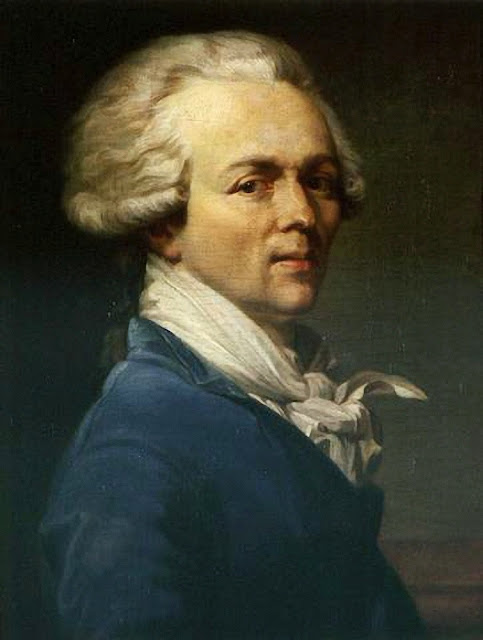 |
| Portrait by Joseph Ducreux, Private Collection, Oil on canvas 48.3cm x 36.2cm https://commons.wikimedia.org/wiki/File:Robespierre_Ducreux.jpeg |
Here is another portrait of Robespierre which has lately appeared on the internet! This picture, by Joseph Ducreux, went under the hammer at Sotheby's New York in January 2003 for $45,000 - 80% more than the estimate. Despite Ducreux's close association with the Royal family, he returned to Paris from London in late 1791 and, under the protection of David, exhibited a number of portraits of prominent Revolutionary figures. The Dictionary of Pastellists lists three Robespierres. The earliest documentation for this one is in the collection of the banker and diplomat Paul Flury Hérard (1836-1913). It was previously sold by Drouot in 1919.
Is this really Robespierre? The pinched mouth and receding chin seem unfamiliar; certainly there is no echo of the firm jawline of the lifemask. Unsettling too is the haunted look. If it is a true image of Robespierre, it is a prematurely aged Robespierre in his final, increasingly paranoid phase; I for one find it deeply disturbing.
References
Sotheby's New York, Important Old Master Paintings 23rd January 2003, Lot 101
Entry for Ducreux in the Dictionary of Pastellists
http://www.pastellists.com/Articles/Ducreux.pdf

Nope, this is another Ducreux self-portrait.
ReplyDeleteHum - could well be....Glad I didn't pay $45000 for it!
DeleteCan you imagine Max ever, ever letting himself be painted with such a badly-tied cravat?!!
ReplyDeleteAgreed. I am sure you are right that this is a self-portrait (just like one in the Rosebery collection which was misidentified as "Robespierre by Greuze").
DeleteSo sadly, despite the documentation, we have no candidates for a Ducreux Robespierre?
Sadly, no – and of course, a number of images of him were destroyed for political reasons after Thermidor. The Duplays destroyed at least one portrait and various papers in 1815, presumably because of the fall of Napoleon/Bourbon restoration. It's possible the Ducreux and the Boze have been lost, or are "unknown gentlemen" hidden in some collection.
DeleteThe oval portrait at Versailles (the one with the huge amber eyes and the golden brown hair visible under the wig) might merit more investigation as to artist identity. It's of decent quality and seems to be the source of a lot of other secondary images.
The most reliable images seem to be that Versailles oval, the Fouquet/Chrétien physionotrace 'grand trait' and engraving, the Guérin profile (possibly another physionotrace), the August 1793 engraving (physionotrace?), Deseine's bust, and the Gros, Gérard and Grandmaison drawings.
The famous stripy Carnavalet portrait rings warning bells with me because there's something 'off' with the proportions in a way that seems unlikely if painted from a 3D real-life subject. I do wonder if it's posthumous and copied from an engraving or a now-lost painting? It would be interesting if it's ever been x-rayed, as to what prep work underlies it.
I'm not strongly convinced the Danloux is him. The Boilly – hard to say: the problem is that any documentation re: acquisition/provenance by Lille was lost in WW1, hence 1920s identification is open to question.
The pastel profile used by Scurr and Martin on their bookcovers is a Fouquet grand trait of some other deputy of the Third Estate: the nose and jawline don't match Max's known physionotrace at all. If they were the same sitter, they would, because of the nature of the technique.
This comment has been removed by the author.
ReplyDeleteHave got Lyon's book on Ducreux… She publishes this painting as him – *despite* a quote from Ducreux himself that the portrait (which he exhibited at the 1793 Salon) was a pastel.
ReplyDeleteThe 2 'missing' important portraits (Labille-Guiard and Ducreux) are both pastels.
The drawing she publishes said to be him looks too young for 1793 date.
Correction: Well, the Ducreux was definitely a pastel.
ReplyDeleteStill have question over Labille-Guiard as she did also work in oils.